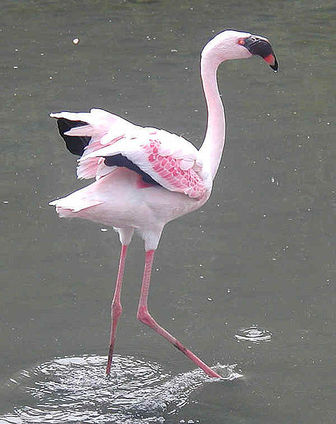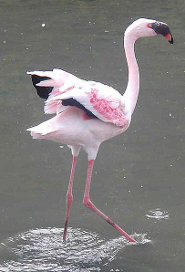Lesser Flamingo
The Lesser Flamingo is the smallest and most numerous flamingo, probably numbering up to two million individual birds. They generally weigh 4.5 lb , are 3 ft long, stand 3 ft 3 in tall, and have a wingspan of 3 ft 3 in .

The Lesser Flamingo - The Littlest One
 The lesser flamingo (Phoeniconaias minor) is the smallest of the four types of flamingos, weighing in at an average 4.5 pounds (2.0 kg). They stand just about 3 feet (1 m) tall with an equal wingspan. They look similar to the Caribbean flamingo, with the long legs and neck, and the hooked bill but are generally a lighter pink.
The lesser flamingo (Phoeniconaias minor) is the smallest of the four types of flamingos, weighing in at an average 4.5 pounds (2.0 kg). They stand just about 3 feet (1 m) tall with an equal wingspan. They look similar to the Caribbean flamingo, with the long legs and neck, and the hooked bill but are generally a lighter pink.
The lesser flamingos’ range runs from southern to eastern Africa and into southwest Asia, and they can primarily be found in areas with brackish water or salty lakes and lagoons. They feed in these areas by holding their bill upside down in the water and filtering out algae and small insects. Their diet consists mainly of spirulina algae, which causes the birds feathers to turn pink, but they also will eat small shrimp if they catch them in their filters.
For breeding, they travel in large flocks to just a handful of different breeding sites. In Africa there is Lake Natron in Tanzania, as well as Etosha Pan, Sua Pan and Kamfers Dam. In northwestern India they use the two salt pans, Zinzuwadia and Purabcheria. Although the lesser flamingo gathers in large, noisy flocks, they do form a monogamous couple and both the male and female will take turns tending to the single egg that is laid. Once the egg hatches, the chicks will gather in crèches. These groups, sometimes growing into the hundreds of thousands, are watched over by just a few of the adult lesser flamingos. The adults will then help lead the chicks across land, crossing distances up to 20 miles (32 km) to get to fresh water.
Their natural predators are the marabou stork and several types of vultures, which go after their chicks and eggs. The mature lesser flamingo is preyed upon by baboons and wildcats, including lions, leopards, and cheetahs. The greatest threats to the lesser flamingo however are humans and their development. The lesser flamingo is considered to be at “Near-Threatened†status. Even though, at nearly 2 million, they are the most numerous of all the four types of flamingos, their breeding grounds and habitats are slowly being either taken over or polluted by development. Current plans to develop a soda ash extraction plant near Lake Natron, the largest of the African breeding grounds, could cause the lesser flamingos’ threat level to be worsened.
The Lesser Flamingo is classified as Near Threatened (NT), is close to qualifying for or is likely to qualify for a threatened category in the near future.

Original source: Paul Mannix
Author: Paul Mannix
Permission: Some rights reserved
Family : Phoenicopteridae
Genus : Phoeniconaias
Species : minor
Authority : (Geoffroy Saint-Hilaire, 1798)
